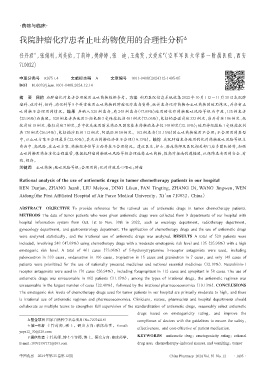Page 93 - 《中国药房》2024年12期
P. 93
·药物与临床·
我院肿瘤化疗患者止吐药物使用的合理性分析
Δ
#
*
任丹君 ,张娟利,刘美佑,丁莉坤,樊婷婷,张 迪,王婧雯,文爱东(空军军医大学第一附属医院,西安
710032)
中图分类号 R975+.4 文献标志码 A 文章编号 1001-0408(2024)12-1495-05
DOI 10.6039/j.issn.1001-0408.2024.12.14
摘 要 目的 为肿瘤化疗患者合理使用止吐药物提供参考。方法 利用医院信息系统收集2022年10月1日-11月30日我院肿
瘤科、放疗科、妇科、消化科等9个科室使用止吐药物的肿瘤化疗患者资料,统计患者化疗药物和止吐药物的使用情况,并分析止
吐药物不合理用药情况。结果 共纳入 520 例患者,有 248 例患者(47.69%)使用的化疗药物致吐风险等级为中度,135 例患者
(25.96%)为高度。520例患者共使用5-羟色胺3受体拮抗剂461例次(73.06%),包括帕洛诺司琼333例次、昂丹司琼106例次、托
烷司琼15例次、格拉司琼7例次,其中优先使用国采药品及国家基本药物的患者仅148例次(32.10%);使用神经激肽1受体拮抗剂
共170例次(26.94%),包括福沙匹坦112例次、阿瑞匹坦58例次。162例患者(31.15%)的止吐药物使用不合理;不合理用药类型
中,以止吐方案不合理最多(22.40%),其次为药物经济性不合理(19.13%)。结论 我院肿瘤患者使用的化疗药物致吐风险等级主
要为中、高风险,在止吐方案、药物经济性等方面存在不合理情况。建议医生、护士、临床药师及医院相关部门应多团队协作,加强
止吐药物用药标准化全程监管,根据抗肿瘤药物致吐风险等级合理选择止吐药物,提高对指南的遵循度,以保障患者用药安全、有
效、经济。
关键词 止吐药物;致吐风险等级;合理用药;化疗所致恶心呕吐;肿瘤
Rational analysis of the use of antiemetic drugs in tumor chemotherapy patients in our hospital
REN Danjun,ZHANG Juanli,LIU Meiyou,DING Likun,FAN Tingting,ZHANG Di,WANG Jingwen,WEN
Aidong(the First Affiliated Hospital of Air Force Medical University, Xi’an 710032, China)
ABSTRACT OBJECTIVE To provide reference for the rational use of antiemetic drugs in tumor chemotherapy patients.
METHODS The data of tumor patients who were given antiemetic drugs were collected from 9 departments of our hospital with
hospital information system from Oct. 1st to Nov. 30th in 2022, such as oncology department, radiotherapy department,
gynecology department, and gastroenterology department. The application of chemotherapy drugs and the use of antiemetic drugs
were analyzed statistically, and the irrational use of antiemetic drugs was analyzed. RESULTS A total of 520 patients were
included, involving 248 (47.69%) using chemotherapy drugs with a moderate emetogenic risk level and 135 (25.96%) with a high
emetogenic risk level. A total of 461 cases (73.06%) of 5-hydroxytryptamine 3-receptor antagonists were used, including
palonosetron in 333 cases, ondansetron in 106 cases, tropisetron in 15 cases and granisetron in 7 cases, and only 148 cases of
patients were prioritized for the use of nationally procured medicines and national essential medicines (32.10%). Neurokinin-1
receptor antagonists were used in 170 cases (26.94%), including fosaprepitant in 112 cases and aprepitant in 58 cases. The use of
antiemetic drugs was unreasonable in 162 patients (31.15%); among the types of irrational drugs, the antiemetic regimen was
unreasonable in the largest number of cases (22.40%), followed by the irrational pharmacoeconomics (19.13%). CONCLUSIONS
The emetogenic risk levels of chemotherapy drugs used for tumor patients in our hospital are primarily moderate to high, and there
is irrational use of antiemetic regimen and pharmacoeconomics. Clinicians, nurses, pharmacists and hospital departments should
collaborate as multiple teams to strengthen full supervision of the standardization of antiemetic drugs, reasonably select antiemetic
drugs based on emetogenicity rating, and improve the
Δ 基金项目 国家自然科学基金项目(No.72074218) compliance of doctors with the guidelines to ensure the safety,
*第一作者 主管药师,硕士。研究方向:临床药学。E-mail:
effectiveness, and cost-effective of patient medication.
yaya12_30@126.com
# 通信作者 主任药师,博士生导师,博士。研究方向:临床药学。 KEYWORDS antiemetic drug; emetogenicity rating; rational
E-mail:18991397171@163.com drug use; chemotherapy-induced nausea and vomiting; tumor
中国药房 2024年第35卷第12期 China Pharmacy 2024 Vol. 35 No. 12 · 1495 ·

